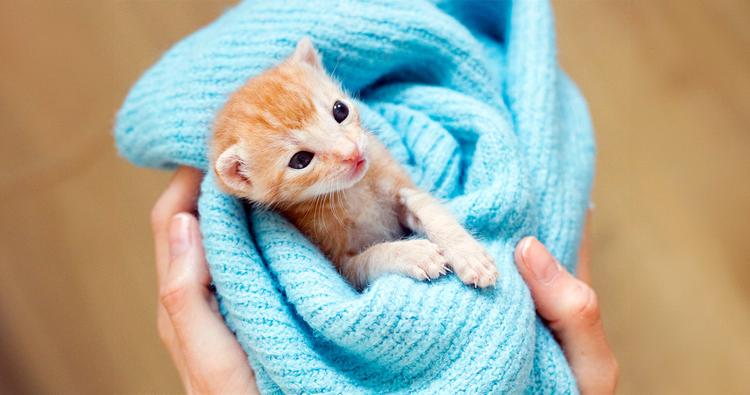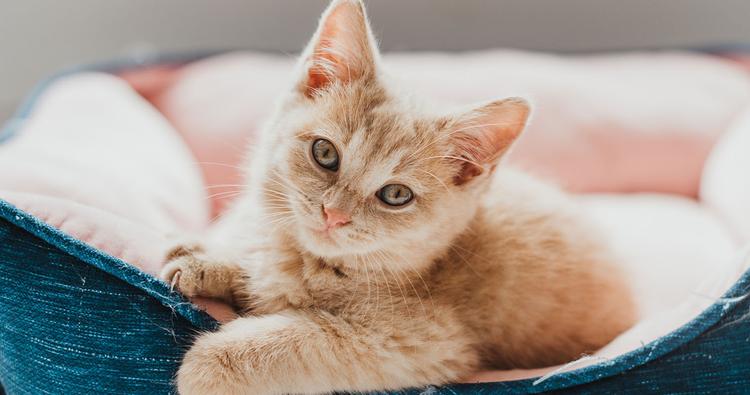10 Signs a Kitten Is Settling In
Kittens and cats can be quite mysterious, so how can you really tell if they feel safe and secure? Look for these tell-tale signs.
Kittens and cats can be quite mysterious, so how can you really tell if they feel safe and secure? Look for these tell-tale signs.
by Janelle Leeson, | September 2, 2024

Olezzo / Shutterstock
Bringing home a kitten is an exciting adventure. But remember, new surroundings, unfamiliar faces, and new sounds and smells are big changes for these small companions. According to Dr. Kelly Hood, a veterinarian for Highlands Veterinary Center, it can take anywhere from a few days to a couple of months for a new kitten to settle in.
Even if you feel unsure about how to raise a kitten at first, you’ll get to know your kitten’s unique personality better than anyone. Soon enough, you’ll be able to distinguish their playful meows from hungry cries, their preferred play and cuddling styles, and more. But before all of that, you’ll notice the signs your new cat is adjusting to life at home, like the ones below.
It’s normal for kittens to be shy when they first arrive home. “Each kitten is unique,” says Dr. Hood, a spokesperson for Pet Portraits. “Kittens from foster homes often adjust more quickly, while rescued kittens with less socialization might need several weeks or even months. It really comes down to the kitten’s individual personality and past experiences.”
If your new kitten is hiding or seems scared, this is a common part of the adjustment process. However, your kitten may be more comfortable than you realize. Here are 10 signs that your kitten is settling in.
What it means: They are relaxed enough to engage.
A playful kitten is often a happy kitten. “When kittens are playing with toys, they are essentially learning how to hunt,” says Heather Alvey, a certified cat-behavior consultant and owner of Felidae Behavior Consulting. When a kitten feels confident enough to pounce on a toy mouse or attack a catnip kicker, it’s a clear sign they are feeling safe in their surroundings and developing their skills.
If your kitten isn’t showing interest in playing, Alvey suggests using wand toys. They let you interact with your kitten without getting too close. While kittens can turn just about anything into a toy, Alvey recommends sticking to cat toys that aren’t too big or scary-sounding.
What it means: They feel safe enough to perform a vulnerable activity.
Using the litter box can be a vulnerable time for cats and kittens, because they could be caught off guard by a predator. When your kitten consistently uses their litter box, they feel safe from potential threats.
Thanks to their natural instincts and what they’ve learned from their mom and littermates, kittens typically don’t need litter-box training. However, they do count on you to provide a comfortable litter-box experience.
Provide one or more kitten-friendly litter boxes in quiet spots around the house. Place them away from your kitten’s food and water. While Dr. Hood says most cats prefer unscented litter, Alvey suggests providing different types and textures to learn which ones your kitten prefers.
What it means: They’re getting the nutrients they need, and associating positive experiences like mealtime with their humans.
Kittens are bundles of energy who need frequent meals to fuel their big growth spurts. While shy kittens might eat less at first, you should see their appetite improve as they settle in.
To encourage normal eating and drinking, create a calm feeding environment. Sit nearby and speak softly to reassure your kitten, but avoid forcing any interactions. According to Dr. Hood and Alvey, establishing a consistent feeding routine (rather than free feeding) can help your kitten associate positive mealtimes with your presence.
What it means: They want more of your attention.
Cats don’t typically meow to communicate with other cats. Instead, they meow to talk to us. It might take some time to figure out if they want food, playtime, or just some love, but generally, gentle meows, chirps, or trills often indicate a happy kitten who wants your attention.
On the other hand, louder and more persistent vocalizations like yowling, lots of meowing, or hissing usually mean distress or discomfort. Paying close attention to your cat’s vocalizations and body language can help you understand their needs.
What it means: Your kitten is becoming a social, happy cat.
Look for relaxed body-language cues such as a loose posture, half-closed eyes, and a loosely curled tail. Oftentimes, happy body language will be accompanied by a soft — or rumbling — purr. “If they’re rubbing against you while purring, that’s a good sign,” Dr. Hood says.
What it means: They’re feeling comfy and content, like a kitten with their mother.
When kittens knead their paws back and forth on a soft surface (or even on you), it’s a sign that they’re feeling relaxed and happy. This endearing behavior, often called “making biscuits,” is a remnant of kittenhood. Kittens knead their mom’s belly while nursing to stimulate milk flow, and this motion becomes associated with comfort and security.
But pay attention to context, Dr. Hood adds. “If they’re purring and look relaxed while kneading, that’s definitely a good sign. But if they seem tense or are kneading excessively, it could indicate they’re feeling stressed or anxious.”
What it means: They’re relaxed enough to perform normal self-care behaviors.
Kittens start grooming themselves and their littermates when they’re around four weeks old. They spend about 10 percent of their day on self-care, often grooming after meals or playtime — a sign of satisfaction. A sure sign that you’re developing a deep bond with your kitten is when they start grooming you.
However, Alvey cautions that if your cat is grooming more than 10 percent of the day, focusing on one specific area, or you notice patches of missing hair where they groom — these could be signs of stress.
What it means: They’re comfortable enough to let their guard down.
A relaxed kitten sleeps in relaxed positions, like a belly-up sprawl or outstretched paws. As trust grows, kittens may choose to nap on their human’s lap, nearby surfaces, or even the keyboard. However, not all cats are lap cats, so don’t take it personally if your cat prefers their own bed.
What it means: They’re curious and confident.
Kittens are naturally curious, but it takes time to adjust to a new environment. Start by creating a safe space in an extra room with everything your kitten needs: a litter box, food, water, bed, and toys. This helps them feel secure while they get used to their new surroundings.
Most kittens take about a week or two before they’re ready to explore more of the house, but each kitten is different, Dr. Hood says. Once they feel confident, there’s no stopping those little paws: You’ll notice them sniffing around, climbing furniture, and checking out new rooms. They might even start following you around.
What it means: They’re developing secure relationships.
You’re eager for your kitten to meet everyone, but it’s important to be patient. Watch for other signs your kitten is settling in — like playing, exploring, and using the litter box — before introducing them to kids and other pets. Alvey cautions that rushing things could scare your kitten.
When introductions happen, remember that peaceful coexistence is a great start. As your kitten builds stronger bonds with your family, look for positive signs like playing together, sleeping near one another, or even mutual grooming.
Welcoming a new kitten can be a whirlwind of happiness, love, and a bit of mystery. It’s normal for your kitten to be shy at first, even hiding at times. Be patient, and follow these tips to help them feel at home.
Create a safe space: Set up a cozy area with kitten essentials: a bed, food, water, litter box, and toys.
Introduce to humans gradually: Slowly introduce your kitten to the rest of your home as they become more comfortable.
Keep interactions soft: Speak softly to your kitten, and avoid sudden movements that could spook them.
Feed consistent meals: Provide regular, consistent meals to establish a routine.
Focus on interactive play: Use interactive toys, like wands, to play and bond with your kitten.
Conduct slow animal introductions: Don’t rush introductions with other pets. Let your kitten adjust at their own pace.
Most kittens adjust well to their new homes. Just look for the signs that they’re settling in. The small things that indicate a happy kitten can be easy to miss if you’re unsure of what to look for. If you still feel as though you’re struggling to bond with your kitten or they’re having trouble adjusting, reach out to a certified feline behaviorist or your vet for help.
“When kittens feel safe and secure, they’ll start exploring, eating and drinking normally, and interacting with their new family,” Dr. Hood says. “You might catch them playing, grooming themselves, or sleeping in relaxed positions. They’ll also use the litter box regularly and may even start seeking your attention.”
When kittens bond with their people, they’ll seek you out for attention, purring simply when you’re near. They might bring you their toys, follow you around the house, or try to groom or knead on you. However, each cat and kitten is different, so the more time you spend with your kitten, the more you’ll recognize their unique signs of affection.
“A happy kitten is playful, curious, and interactive,” Dr. Hood says. “You’ll notice them eating well, grooming regularly, and sleeping soundly.” To keep your kitten happy, provide a balanced diet, see the vet regularly, and offer plenty of playtime and enrichment. Most importantly, provide your kitten with love and attention in a way they enjoy.

Janelle Leeson is a Portland, Oregon-based freelance writer. Her work has been featured in magazines such as Inside Your Dog’s Mind, Inside Your Cat’s Mind, and Paw Print, as well online at Insider Reviews, NBC Select, Shop Today, PetMD, and Daily Paws. She has two adventure cats, a flock of urban chickens, and a soon-to-be-husband who doesn’t mind housing the occasional foster cat — or five.

Adoption Advice

Behavior & Training

Behavior & Training

Adoption Advice
By creating a safe space, respecting your cat’s boundaries, and using positive reinforcement, a shy cat can absolutely thrive in your home.

Adoption Advice
Considering adopting a cat? This comprehensive guide covers all the practical advice that will help you make an informed decision.

Foster & Volunteer
During the warmer months, kitten births skyrocket — and it has a dramatic effect on shelters

Behavior & Training

Adoption Advice
Adopting a new kitten? We've created a checklist to help you get organized before bringing your new friend home.

Adoption Advice
Thinking about adding another cat to your home? Here’s how to expand your family, minus the drama.

Adoption Advice
Are you bringing home a new kitten? Find out the best way to introduce your new kitten to your crew.

Behavior & Training

Behavior & Training